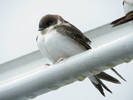search
classification
|
basic information
|
video
|
reports |
Northern House Martin
Delichon urbica (Linnaeus, 1758)

|
 adult
|
|
|
2021-05-12
Besh-kungey, Chuy region |
© Tatiana Menshikova
|
|
Description
The House Martin is less than Sparrow bird. Upperparts are black with bluish metallic gloss, underparts are all white. The tail is not deep-cut. The well specific feature is the white rump appreciable from a far. There is not dark band on the breast. Legs are feathered up to claws. Males and females are similar; there are no differences in color on all seasons. Juveniles are similar to adults but its upperparts are grayish-black with a bit of bluish metallic gloss, flanks and breast are with brownish tinge. Weight 14-25 grams, length 14-17, wing 9,8-11,8, wingspan 29-33 sm.
Biology
The House Martin is common breeding migrant. It inhabits the being near water the caves and cavities in the cliffs and rocks; steep river banks; bridges; but mostly the buildings and other constructions in towns and villages, both on the plains and in the mountains up to 1800 m in Altai and 3000 m in Tien Shan. In spring it appears in small flocks of up to dozen birds in late March – early April in southern areas, and in late April – mid May in northern ones and highlands. At Chokpak Pass the last spring migrants recorded on mid – late May. Breeds in colonies of several dozen pairs; single nests are very rare. Firstly it settles the retained old nests. The quarter-sphere-shaped nest is built in cavity or under the roof or cornice; from the mud balls mixed with some grass or hair; and is lined with the thin grass and feathers. Both partners build it for about two weeks. Clutches of 2-6 (more often of 4-5) eggs is in early May – mid July. Both parents incubate for 12-15 day and feed juveniles, which fledge at 20-25 days old, in early July – mid August. It is probable that House Martins are double-brooded. It eats by the flying mostly little insects which are caught during the flight on the open countries. On the murky-rainy weather the House Martins don't hunt staying this time in the nests; or bunch and warm in the accommodation and attics. The autumn migration starts in late July, majority of birds migrate on late August – mid September in flocks up to several hundreds birds, often with Barn Swallow, Pale Sand Martin, Sand Martin and Red-rumped Swallow. Last autumn migrants recorded in early – mid October.
References
Gavrilov E. I., Gavrilov A. E. "The Birds of Kazakhstan". Almaty, 2005.
В.К.Рябицев. "Птицы Урала, Приуралья и Западной Сибири". Екатеринбург, Изд-во Уральского университета, 2000.
Э.И.Гаврилов. "Фауна и распространение птиц Казахстана". Алматы, 1999.
unidentified birds
Анатолий Таран: Желтогрудый князёк
xxxx: плохо видно, но мне кажется это кулики либо песочники.
хххх: да. это крохаль, но скорее всего средний. длинноносый который. из за красной шеи. много лет не мог определить вид этой птицы. гугл мугл не помогад. [....]
















